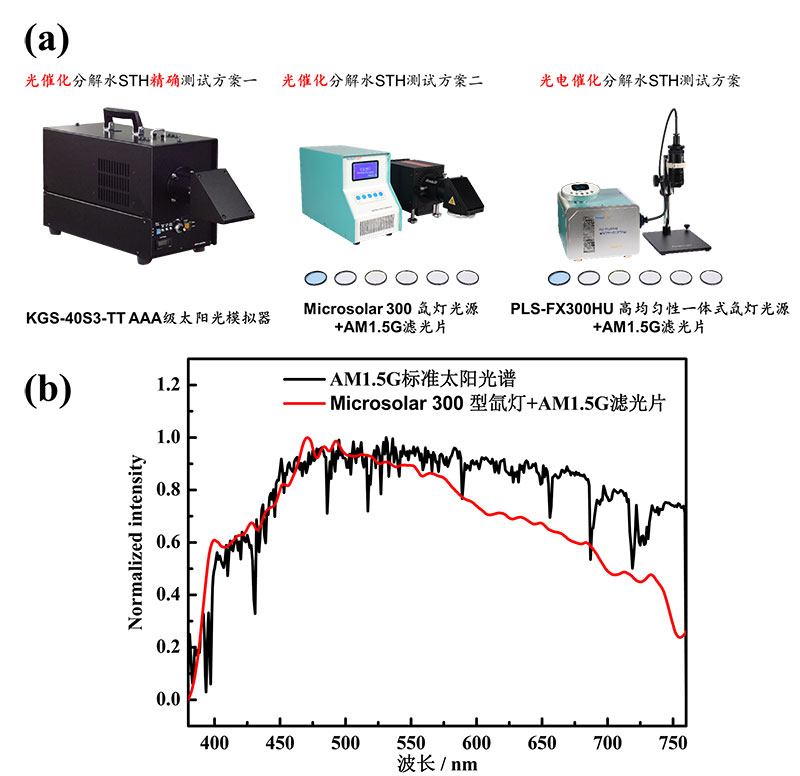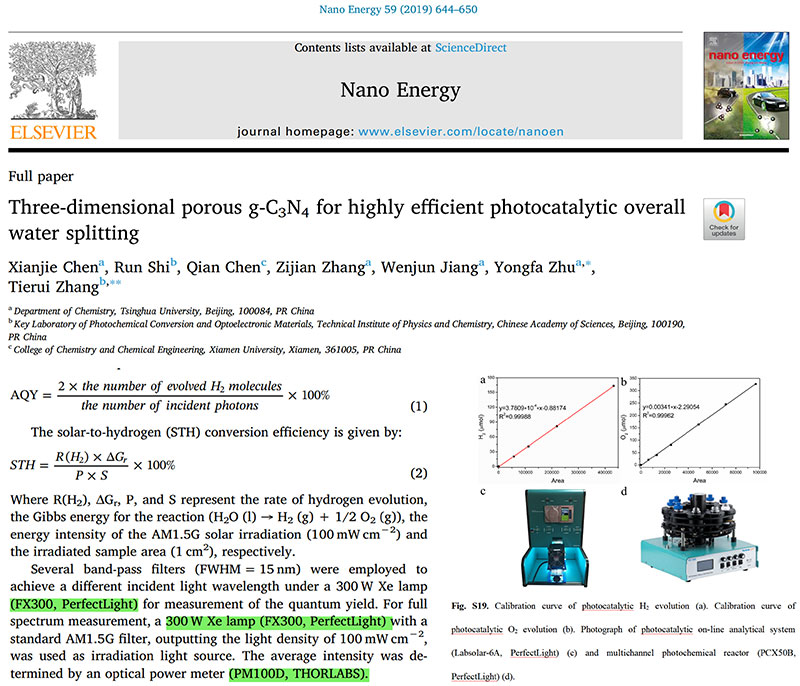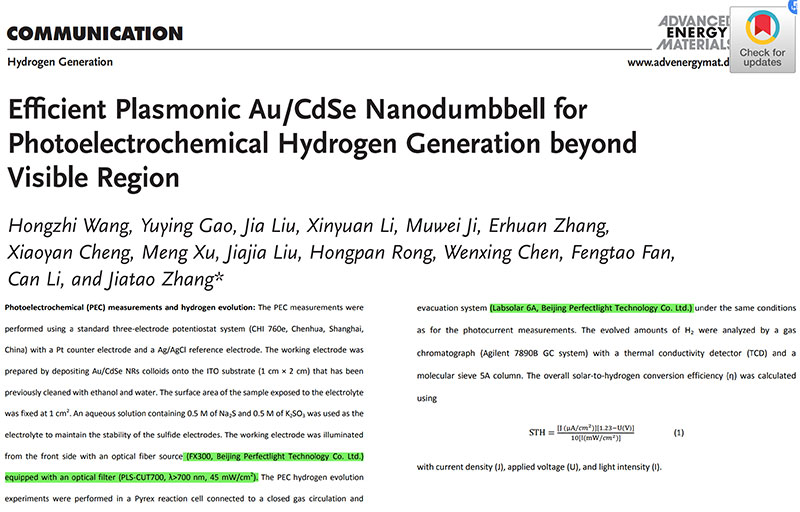When Solar to Hydrogen (STH) reaches 5-10%, photocatalytic water splitting for hydrogen production becomes economically viable[1]. Currently, the main activity evaluation parameters in photocatalytic water splitting for hydrogen production research are normalized photocatalytic hydrogen production rate (μmol·h-1·g-1 or mmol·h-1·g-1), quantum yield (AQY), and STH energy conversion efficiency. However, the normalized photocatalytic hydrogen production rate is influenced by factors such as incident light wavelength range, light intensity, reactor type, and reaction temperature, leading to an inability to compare data results between different laboratories under unified standards[2]. Therefore, the two primary indicators for evaluating catalysts in photocatalytic water splitting for hydrogen production are AQY and STH energy conversion efficiency. Regarding AQY, detailed explanations are provided in the article "Quantum Yield (AQY) Calculation Tutorial - You Deserve to Have It!"
STH energy conversion efficiency measures the efficiency of converting solar energy input into hydrogen energy and is the practical standard for assessing photocatalysts in water splitting reactions[3].
1. The calculation formula for STH energy conversion efficiency in photocatalytic water splitting reactions is as follows[2]:

RH₂: Photocatalytic hydrogen production rate (mmol·s-1);
∆Gr: Molar Gibbs free energy of water splitting reaction (J·mol-1);
Psun: Light power density of AM 1.5G standard solar spectrum (100 mW·cm-2);
S: Illuminated area (cm2).
The standard molar Gibbs free energy of water splitting  , formula (1-1), can be simplified[4]:
, formula (1-1), can be simplified[4]:

In theory, STH energy conversion efficiency can also be calculated by integrating the quantum efficiency of all wavelengths, with the formula as follows[5]:

λI: Starting wavelength of AM1.5G standard solar spectrum;
λF: Ending wavelength of AM1.5G standard solar spectrum;
QE: Quantum efficiency under standard conditions.
2. The calculation formula for STH energy conversion efficiency in photoelectrocatalytic water splitting reactions is as follows[6]:

Jsc: Short-circuit photocurrent density (mA·cm-2);
E: Thermodynamic decomposition potential of water (V);
ηF: Faraday efficiency;
Psun: Light power density of AM1.5G standard solar spectrum (100 mW·cm-2).
Similarly, the standard thermodynamic decomposition potential of water  =1.23 V, and formula (2-1) can be simplified[6]:
=1.23 V, and formula (2-1) can be simplified[6]:

When using the above formulas, the following points should be noted[2]:
1. The calculation of STH energy conversion efficiency is only applicable to the full water splitting reaction with an H₂:O₂ molar ratio of 2:1, and it does not apply to the hydrogen production half-reaction with hole sacrificial agents present. Since hole sacrificial agents also participate in the reaction, ∆Gr and E values may change;
2. ∆Gr and E values are different at different temperatures and pressures and need to be corrected according to the actual reaction temperature and pressure;
3. The light source spectrum must comply with the AM1.5G standard solar spectrum, and the light power density should be 100 mW·cm-2.
From the above formulas, it can be seen that the two necessary conditions for accurately measuring photocatalytic/photoelectrocatalytic STH energy conversion efficiency are:
① Accurate measurement of photocatalytic hydrogen production rate;
② AM1.5G standard solar spectrum.
Regarding the accurate measurement of photocatalytic hydrogen production rate, the reaction system should pay attention to the following interfering factors:
1. Avoid measurement errors caused by offline manual injection;
2. Avoid uneven mixing of H₂ and O₂ in a short period of time.
Regarding obtaining the AM1.5G standard solar spectrum, there are two common methods: ① directly use a solar simulator ② use a xenon lamp light source with an AM1.5G filter, as shown in Figure 1.

Figure 1. (a) Physical picture of the solar simulator and xenon lamp with AM1.5G filter, (b) Spectral diagram of AM1.5G standard solar spectrum with Microsolar 300 xenon lamp and AM1.5G filter
Professor Zhu Yongfa from Tsinghua University and Researcher Zhang Tierui from the Institute of Chemistry, Chinese Academy of Sciences, used the Beijing Perfectlight PLS-FX300HU High Uniformity Integrated Xenon Lamp as the light source for photocatalytic full water splitting experiments, and analyzed the H₂ and O₂ contents online using the Beijing Perfectlight Labsolar-6A system, as well as measured the STH energy conversion efficiency of photocatalytic water splitting reactions. The relevant results have been published in Nano Energy[7].

Professor Zhang Jiatao's research group at Beijing Institute of Technology used the scheme with the PLS-FX300HU High Uniformity Integrated Xenon Lamp as the light source for photoelectrocatalytic water splitting experiments, analyzed the H₂ content online using the Labsolar-6A All-Glass Automatic Online Trace Gas Analysis System, and measured the STH energy conversion efficiency of photoelectrocatalytic water splitting reactions. The relevant results have been published in Advanced Energy Materials[8].

Figure 3. Classic Case - Measurement of Photoelectrocatalytic Water Splitting STH
[1]Matthew R. Shaner, Nathan S. Lewis*, Eric W. McFarland*, et. al., A comparative technoeconomic analysis of renewable hydrogen production using solar energy[J]. Energy Environmental Science, 2016, 9, 2354.
[2]Wang Zheng, Li Can, Kazunari Domen*, Recent developments in heterogeneous photocatalysts for solar-driven overall water splitting[J]. Chemical. Society. Reviews, 2019, 48, 2109.
[3]Li Rengui, Li Can*, Photocatalytic water splitting on semiconductor-based photocatalysts[J]. Advances in Catalysis, 2017, 60, 1.
[4]Li Yiyang, Wang Zihan, Tsang Shik Chi Edman* et. al., Local magnetic spin mismatch promoting photocatalytic overall water splitting with exceptional solar-to-hydrogen efficiency[J]. Energy Environmental Science, 2022. DOI: 10.1039/d1ee02222a
[5]Qureshi Muhammad, Takanabe Kazuhiro *, Insights on measuring and reporting heterogeneous photocatalysis: efficiency definitions and setup examples[J]. Chemistry of Materials, 2017, 29, 158.
[6]Chen Zhebo, Deutsch Todd G., Jaramillo Thomas F.* et. al., Accelerating materials development for photoelectrochemical hydrogen production: Standards for methods, definitions, and reporting protocols[J]. Journal of Materials Research, 2010, 25, 3.
[7]Chen Xianjie, Zhu Yongfa*, Zhang Tierui* et. al., Three-dimensional porous g-C3N4 for highly efficient photocatalytic overall water splitting [J]. Nano Energy, 2019, 59, 644.
[8]Wang Hongzhi, Guo Yuying, Zhang Jiatao* et. al., Efficient plasmonic Au/CdSe nanodumbbell for photoelectrochemical hydrogen generation beyond visible region[J]. Advanced Energy Materials, 2019